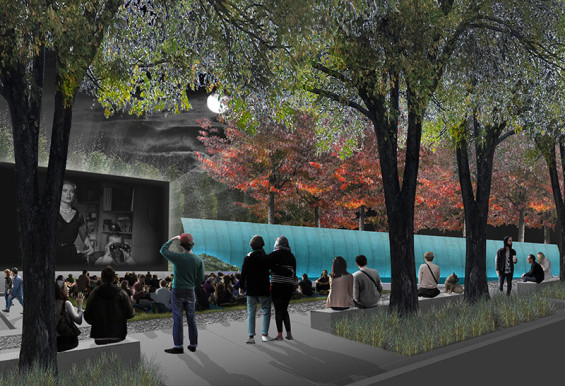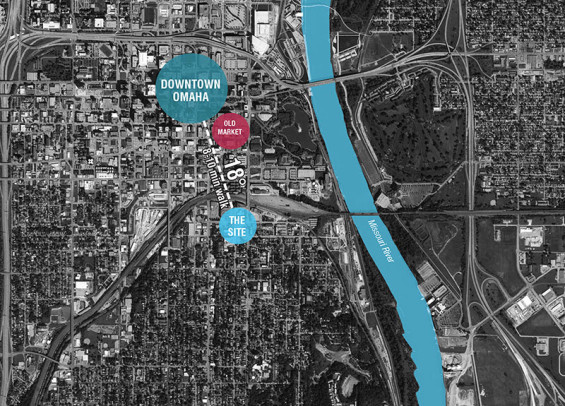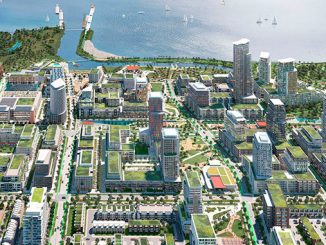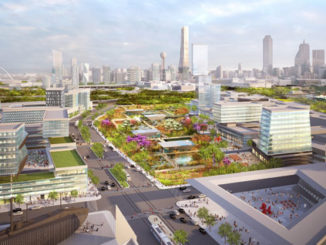Defined by its undulating topographic mounds, expansive plains, natural bluffs and the meandering Missouri River, Omaha’s original settlement patterns responded to this picturesque landscape and gave way to the native translation of “city of mound dwellers.” When abstracted within the boundaries of a 7,000 square foot public plaza these four landscapes – mound, plain, river and bluff – unite to create an innovative public space indicative of its greater region, and one which provides numerous benefits for the new Bluebarn Theater, the residents of Little Italy/Near South Side and the greater community of Omaha.
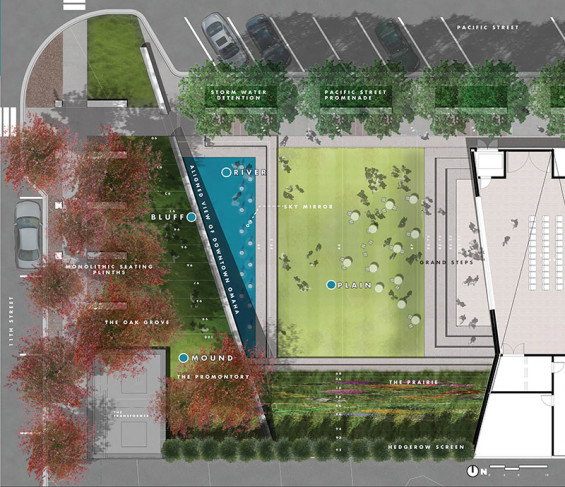
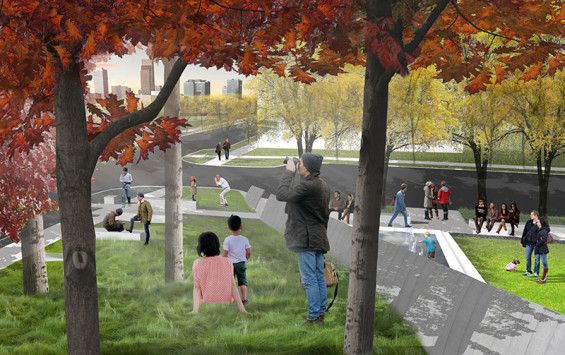
18° Off North leverages the site’s physical qualities, history and skyline views – while directly responding to the public’s three biggest concerns – noise from the adjacent the postal annex, the exposure to sun and wind and pedestrian movement free of obstacles. The “bluff” wall proposes a creative solution to addressing aspects of noise and human comfort while also using its form to capture views to downtown, creating two distinct and usable spaces. The sky mirror, lawn and mound are conveniently accessed from the periphery street edge. The design team also focused on the creation of strong urban edges for this park. Along Pacific Street the creation of a promenade of street trees and bio-retention cells and a realignment of the curb line create a 50% increase in the current pedestrian realm along the right of way. The vegetated buffer has the capacity to capture 70% of stormwater that falls on the site.
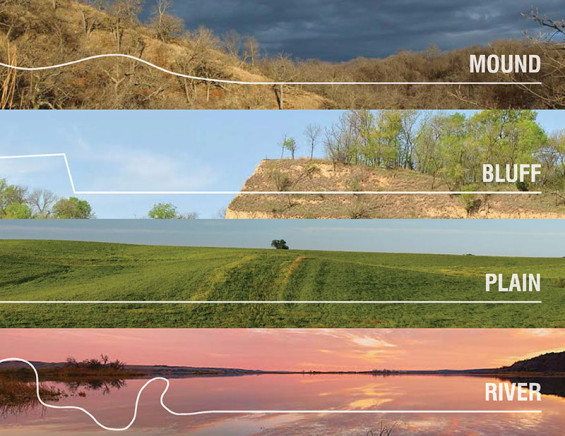
MOUND | Rising from the corner of 11th and Pacific, a tilted meadow culminates into a promontory space where the public is elevated above the surrounding landscape to celebrate the dramatic skyline views to nearby downtown Omaha. Held by the bluff and the transformer walls, the high point rests 10 feet above the street corner and 13 feet above the lower park. During performances, it also offers a promontory view of the actions occurring below. More than 300 cubic yards of material are reused from the deconstruction of the existing Asphalt parking and will be used as the fill material for these landform elements.
PLAIN | The plain abstracts the region’s low-lying landscapes witnessed along the Missouri river and includes a plinth of lawn, a windbreak screen, and a terraced native prairie. Organized as an extension of the interior and set on axis with the stage, the lawn provides an additional 2800 square feet of flexible space for everyday and event activities. A series of monolithic landscape steps surround the lawn and function as 150 additional seats for both interior and exterior performances. Elevated approximately two feet above the building’s finished floor, the lawn maintains a strong relationship to the park’s urban edge and provides an elevated overflow seating area large enough for 110 people to view interior performances.
RIVER | Located at the base of the bluff and forming the backdrop to the lower space, a geometric “sky mirror” references the nearby Missouri River and introduces the ever-changing pattern and movement of reflected light and sound into the public space. Designed with a thin sheet of water and a set of pop jets, the feature not only offers reflective visual drama, but creates an interactive venue for individuals of all ages to gather and to find cooling relief from the region’s intense summer heat. When water is not present, the mirror functions as a platform for a fully outdoor performance space for dance, music and theater. Located on-axis with the Bluebarn’s interior stage, the platform extends the stage/audience rhythm from inside the building into the park.
BLUFF | A monolithic wall, referred to as “the bluff” is envisioned to be the recognized icon of the public space, offering a public and nature spectacle for park goers. Oriented 18 degrees off north to align with distant views of Downtown Omaha, the bluff transitions the architectural vocabulary of the Bluebarn Theater into its surrounding context through a poetic yet restrained intervention. Exploring the concept of prospect and refuge, the bluff amplifies the site’s existing topographic relief in order to create two distinct and usable community spaces.
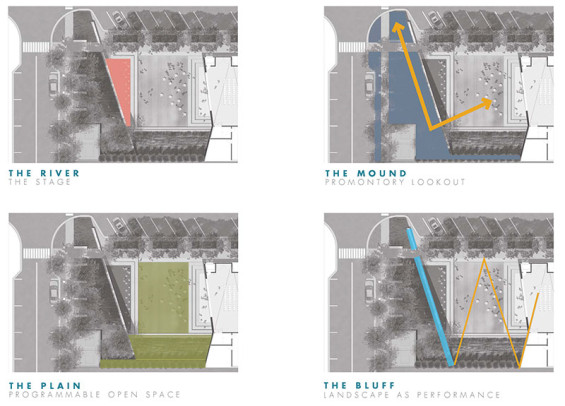
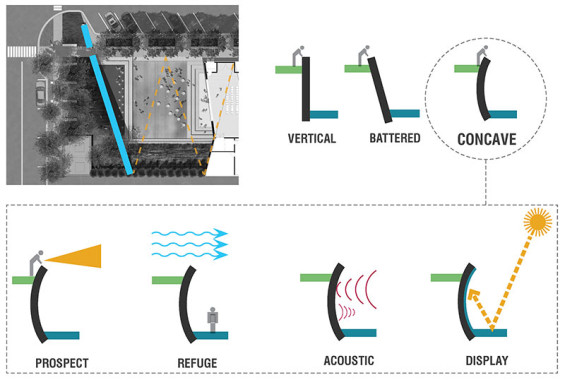
Concave in its form, the inherent design of the bluff’s unique arc provides multiple acoustic, aesthetic and human comfort qualities. Creating a “community conversation,” the wall extends the life of the theater, inviting the public to become their own performer as they interact with the water, wall and other individuals. At dusk, blue lights bring the board-form concrete wall to life, extending the dramatic visual drama into the evening. When the park is used for performances, the design captures and reflects the sounds throughout the space. Furthermore, the bluff’s orientation provides important relief from the region’s intense summer heat and winter winds.
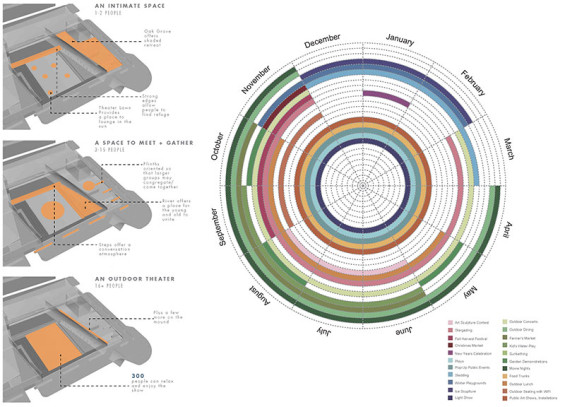
Referencing the vegetated hills surrounding Omaha, a grove of densely spaced Red Oaks provides dappled shade, transforming into a visual spectacle during autumn months throughout all aspects of the park. The planting gesture pays homage to the famous Midwest landscape architect Jens Jensen, who favored red oaks, often placing them in areas which received western sunlight, causing a fire-like planting gesture. Monolithic concrete plinths extend from the landform, providing additional seating opportunities along the park’s edge.
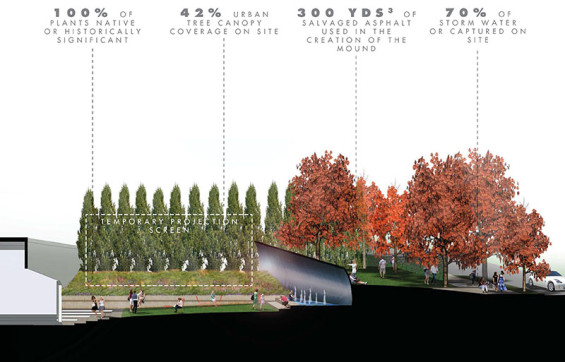
During the winter months, both upper and lower spaces were envisioned to be key assets for the community of Omaha. With its northern aspect and gentle slope, the upper park provides a small sledding hill for children of the area. Within the winter space, the bluff acts a shelter for activities such as snow sculpting and display of works by temporal artists. The design team proposed 12 months of programed activities within the space that ranges from winter sculpture competitions to seasonal lighting shows.
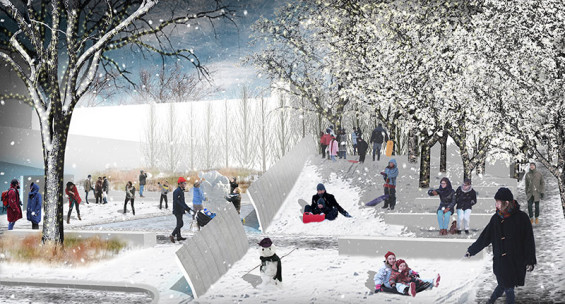
During the day, movable tables and chairs are dispersed throughout, activating the space and enabling individuals to access sun and shade depending on the time of day. At evening, the ambient blue light of the bluff creates a cool vibe for citizens and visitors to congregate. Primarily level, the lawn offers an entertainment venue for outdoor performances, philanthropic events, speaking engagements and year-round community cultural events, including art festivals, film nights and snow sculpting contests. Situated between the bluff and the Bluebarn Theater, the plain may be easily secured along the street edge to allow for ticketed performances and/or private events. Serving as a visual terminus along the park’s southern edge, a row of columnar trees and terraced prairie references the region’s agricultural windbreaks while screening views to the adjacent parking lot.
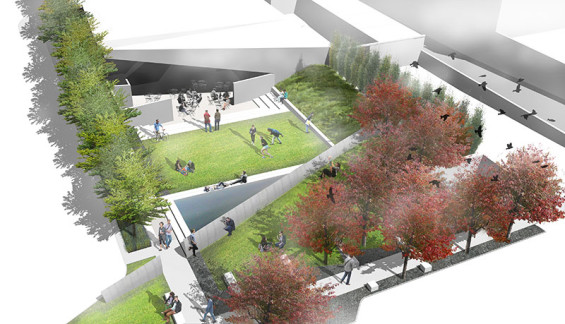
The vast Nebraskan Landscape is abstracted into a series of intimate and flexible public spaces that serve a variety of users. The desires of the larger community, the land owner, and the neighborhood residents can be accounted for through the implementation of this small pocket park. Simple in its design and material selection the space will be easily maintained and though only a quarter of a city block the design is visually striking creating a memorable and lasting space that will serve Omaha for decades to come.
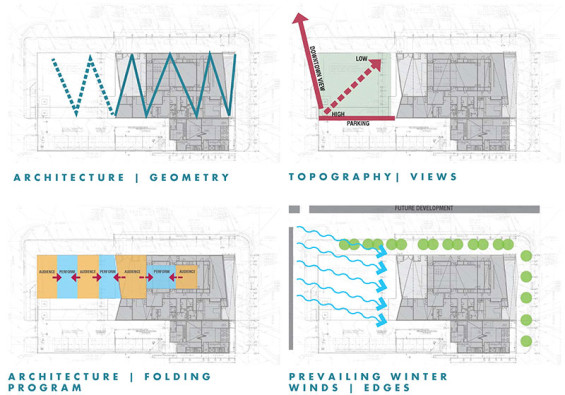
18° Off North | Green in the City
Location | Omaha, Nebraska, USA
Design Firm | Design Workshop, Inc.
Mike Albert, Anna Cawrse, Joshua Brooks, Kurt Culbertson, Adam Mekis, Steven Spears, Andy Wisniewski
Images | All Images are courtesy of Design Workshop, Inc.

